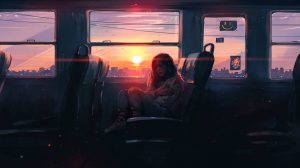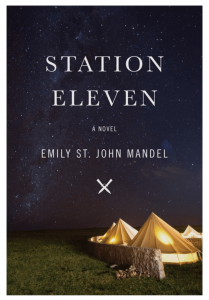Science Fiction and Humanity’s Search for Meaning: Endings and Beginnings
In the world of today, it’s difficult to look towards the future. Instead of dreaming about a glorious future ahead for humanity, we now spend our days bickering about the problems we’ve made for ourselves. When we do speculate on the future, it’s not a good one¾fears of the impact of climate change and global war make it seemingly impossible to imagine a bright future. Every discussion we have is dominated by a need for facts and logic. In the polarized society we live in, as emotional and spiritual appeals become more and more disregarded, it would be easy to argue that there is no longer a need for science fiction. In fact, I’m sure the argument has been made, likely by many people. As we make advances in scientific knowledge and understand the world around us better every day, there seems to be less of a need for the fiction part of science fiction. Why waste our time speculating on silly fictional ideas when we have real problems that are around us and happening right now?
That question isn’t necessary invalid, and it certainly has its merits. In areas such as vaccination and climate change, I agree that it is extremely important to focus on the truth of the science and avoid resorting to fictions. Ignoring reality in favor of stories and conspiracy theories is a dangerous path for humanity to take and should be avoided. However, I am concerned that it we are also facing the danger of leaning too far away from speculation and science fiction. Secularism is on the rise in the Western world as more and more people turn away from religion. Organized religion certainly has more than its fair share of problems, and many arguments could be made that the world might be better off as it disappears. However, religion and spirituality has given meaning to human life since our beginnings. Even before the time of organized religion, the earliest human civilizations were asking questions about their purpose, and the purpose of the world around them. Spirituality is innate in humans, as we yearn for a deeper understanding of ourselves. So why are we abandoning it now? It is foolish to think that we should abandon our tradition of telling stories and theorizing on the big questions because we think we’ve reached a point where that is impossible. Instead of abandoning that line of questioning, we need to embrace it more than ever. That’s where science fiction comes in¾traditionally, sci-fi has been at its most powerful and necessary when grappling with questions of humanity’s purpose. This is why it is so important to continue asking those questions, now not as religious beliefs, but as speculation through science fiction. Darko Suvin defines science fiction as a way to imagine an estranged world which differs from our empirical environment.[1] Now is the time when we need that ability to imagine a different world, as we lose religious ideas which have traditionally filled that role. Science fiction has the ability, more than any other genre, to give meaning to individuals by telling stories about our beginning and about our ending.
BEGINNINGS
Origin stories attempt to answer some of the most fundamental questions of human existence: why are we here, and where did we come from? Those questions have been the subject of mythological and religious stories for thousands of years. There are countless versions, from the Bible story to native creation stories, but they all stem from the same thing: humanity’s deep longing for a purpose. Every individual faces these questions at some point in their life, and it is necessary that we continue asking them. Science has shown us the truth of our origin in the form of the Big Bang Theory. But should that mean that we cease theorizing on why we exist? Of course not. Where we once held strict religious beliefs, we can now satisfy that search for meaning through science fiction. One such way for us to use science fiction to engage with humanity’s origin is by engaging with classical religious ideas in new ways, a technique mastered by Arthur C. Clarke.
More than any other science fiction author, Clarke embodies the synthesis of spirituality and science. Instead of considering knowledge and religion mutually exclusive, he allowed them to coexist in his stories, stating that “Any path to knowledge is a path to God—or Reality, whichever word one prefers to use.”[2] He was staunchly against organized religion and stated that he personally didn’t believe in God or an afterlife,[3] but clearly found the idea worth exploring. His writings came at a time when religion in the Western world was beginning to question if there really was e benevolent God guiding their every step. Clarke’s 1955 story “The Star” came at a time of systemic collapse in America, between the paranoia of McCarthyism and the Cold War, and the soon-to-come chaos of the Vietnam War and the Civil Rights Movement. What defined this time was a removal of rose-colored glasses in America. Suddenly, people had reason to be suspicious of higher powers, both politically and spirituality. In “The Star,” a devout Catholic priest is also an astrophysicist aboard an expedition to explore the star system of a dead star. The crew discovers the remnants of a beautiful civilization, destroyed by the supernova, quite similar to humanity. In a cruel twist of fate, the priest calculates that this was the very same star that proclaimed the birth of Jesus: “oh God, there were so many stars you could have used. What was the need to give these people to the fire, that the symbol of their passing might shine above Bethlehem?”[4] Another story that uses science fiction to question origin stories is the 1972 story The Falsifier by José B. Adolph. Similarly to Clarke, Adolph questions the truth of the Christian biblical story. However, instead of adding ethical consequences to the idea of a Christian God, he rejects the idea altogether. The story focuses on a Peruvian historian struggling with his decision to change the native Incan origin story to one rooted in Catholicism. He calls their story foolish, but in the end it is revealed that the Incans were telling the truth, and the historian’s cover-up is appreciated by the higher beings watching over Earth.[5] Both stories exemplify how authors use science fiction to prompt questions about humanities beginnings.
ENDINGS
Just as important as origin stories to the big questions about humanity are stories of apocalypse and ending. Particularly relevant in a world where it’s hard not to feel doomed, these science fiction stories ask the questions about what happens when it’s all over. What did all of it mean? What happens to us? How does it all end? Some authors attempt to answer these questions within the framework of our preexisting religious ideas about the end. Clarke’s story The Nine Billion Names of God focuses on the idea in a Tibetan monastery that once all nine billion names of God are written down, the purpose of the universe is complete and the world will end. Western supercomputer programmers are hired to help the monks, and the story ends as the supercomputer completes it’s task and the once-skeptical Westerners notice the stars above them extinguishing.[6] Clarke’s synthesis of traditional spiritual ideas and advanced technology offers a thesis that the world’s end will be brought on both by ourselves and by a higher power. Other stories offer more secular theories on the apocalypse, with theories that the end will come from a dangerous product of random science, such as the virus in Octavia Butler’s “Speech Sounds.” In H.G. Wells’ “The Star” (not be confused with Clarke’s aforementioned story of the same name), the warnings about the end of the world are largely ignored until it’s too late. The master mathematician who tried to warn the world becomes a tragic messiah, only few heeding his prophecy before it comes true.[7]
There is value in those stories about these stories of apocalypse, and they can certainly prompt thinking about our existing world and big ideas. However, science fiction is at its best when it offers hope, and many stories of endings do exactly that. It’s difficult to even call them stories of the end, because they are also stories of new beginnings. Arthur Clarke’s novels 2001: A Space Odyssey and Childhood’s End exemplify this approach. In 2001, he explores pathways for the future of humanity, both through artificial intelligence and more spiritual ideas. In the end, a human evolves into a new being called the Star Child, who protects humanity by preventing nuclear war, a clear response to Cold War fears.[8] In Childhood’s End, he subverts the classical Christian imagery of demons by making them aliens Overlords responsible for guiding humanity to its next stage as a single entity no longer constrained by bodies.[9] Isaac Asimov also theorized about the evolution of humanity in his story The Last Question, in which humanity fuses with AI to become an amorphous consciousness that survives long past the end of the world, eventually reversing entropy and restarting the universe. More important, however, is what the consciousness proclaims as he recreates the universe: “And AC said, ‘LET THERE BE LIGHT!’ And there was light –”[10] By reusing that Christian saying, Asimov is challenging our very idea of what a God could be, suggesting that humanity itself will advance to a god-like state. All three of these stories don’t have a sole protagonist, instead telling stories across time and space that create an overall story of humanity’s evolution. They seem almost biblical in their narrative structure, fulfilling the same questions that holy texts have done for years, just with different answers.
In 1966, TIME Magazine released one of their most infamous covers, simple red text on a black background that asks: “Is God Dead?”[11] The magazine examined the idea that in an increasingly scientific world, there was no need for the idea of a God in theology. It came at a time when the Western world was beginning to question the religious institutions that had held it tightly for centuries. Since that time, 34% of Americans have lost faith in their belief in a God.[12] We now live in a world that largely rejects spiritual ideas as silly and irrelevant. However, it is fundamentally important to our continued evolution as a species that we not stop considering the big ideas that spirituality has always brought up. An archetypal reading of religious works and ideas could be used to say that we have essentially been telling the same stories since our beginnings. We have always looked for ways to explain the universe we live in, and considering those questions has always been central to the human experience. As we continue to reject religion, it is increasingly important to use science fiction as a way to challenge our empirical environment.
[1] Arielle Saiber, WSF Class 2 PowerPoint.
[2] “Sir Arthur C. Clarke: The Times Obituary,” The Times, 2008.
[3] “Exclusive interview with Arthur C. Clarke – Life beyond 2001,“ The Island, 2000.
[4] The Star, Arthur C. Clarke, 1955.
[5] The Falsifier, Jose B. Adolph, 1972.
[6] The Nine Billion Names of God, Arthur C. Clarke, 1953.
[7] The Star, H.G. Wells, 1897.
[8] 2001: A Space Odyssey, Arthur C. Clarke, 1968.
[9] Childhood’s End, Arthur C. Clarke, 1953.
[10] The Last Question, Isaac Asimov, 1956
[11] “Is God Dead? At 50,” TIME Magazine, 2016.
[12] Ibid.



